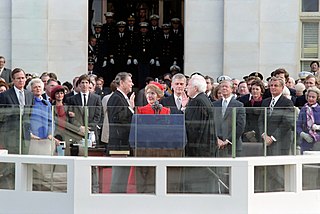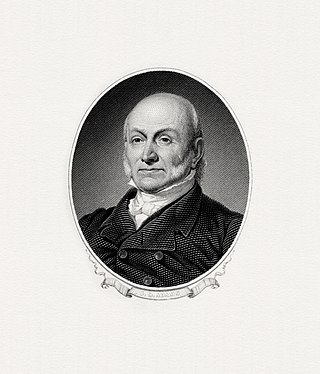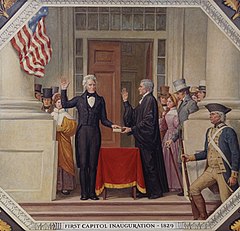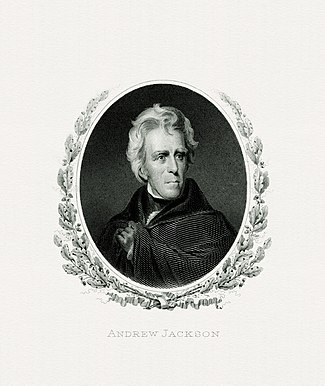
Between 73 and 79 days after the presidential election, the president-elect of the United States is inaugurated as president by taking the presidential oath of office. The inauguration takes place for each new presidential term, even if the president is continuing in office for a second term.

The first inauguration of George Washington as the first president of the United States was held on Thursday, April 30, 1789, on the balcony of Federal Hall in New York City, New York. The inauguration was held nearly two months after the beginning of the first four-year term of George Washington as president. Chancellor of New York Robert Livingston administered the presidential oath of office. With this inauguration, the executive branch of the United States government officially began operations under the new frame of government established by the 1787 Constitution. The inauguration of John Adams as vice president was on April 21, 1789, when he assumed his duties as presiding officer of the United States Senate; this also remains the only scheduled inauguration to take place on a day that was neither January nor March.

The first inauguration of Bill Clinton as the 42nd president of the United States was held on Wednesday, January 20, 1993, at the West Front of the United States Capitol in Washington, D.C. This was the 52nd inauguration and marked the commencement of the first term of Bill Clinton as president and Al Gore as vice president. At 46 years, 154 days of age at the time of his first inauguration, Clinton was the third-youngest person to become president, and the first from the Baby Boomer generation.

The second inauguration of George W. Bush as the 43rd president of the United States took place on Thursday, January 20, 2005, at the West Front of the United States Capitol in Washington, D.C. This was the 55th inauguration and marked the beginning of the second and final term of George W. Bush as president and Dick Cheney as vice president. The ailing Chief Justice William Rehnquist administered the presidential oath of office for the last time before his death on September 3 that year. Attendance at the inauguration has been reported as being around 100,000, 300,000, or 400,000.

The first inauguration of George W. Bush as the 43rd president of the United States took place on Saturday, January 20, 2001, at the West Front of the United States Capitol in Washington, D.C. This was the 54th inauguration and marked the commencement of the first term of George W. Bush as president and Dick Cheney as vice president. Chief Justice William Rehnquist administered the presidential oath of office at 12:01 p.m., after he administered the vice presidential oath of office as well. An estimated 300,000 people attended the swearing-in ceremony. This was the first presidential inauguration to take place in the 21st century, and the first in the 3rd millennium.

The second inauguration of Bill Clinton as the 42nd president of the United States was held on Monday, January 20, 1997, at the West Front of the United States Capitol Building in Washington, D.C. This was the 53rd inauguration and marked the commencement of the second and final term of Bill Clinton as president and Al Gore as vice president. This was the last presidential inauguration to take place in the 20th century, the last in the 2nd millennium, and the first to be streamed live on the internet.

The first inauguration of Ronald Reagan as the 40th president of the United States was held on Tuesday, January 20, 1981, at the West Front of the United States Capitol in Washington, D.C. This was the first inauguration to be held on the building's west side. This was the 49th inauguration and marked the commencement of Ronald Reagan's and George H. W. Bush's first term as president and vice president, respectively. Chief Justice Warren E. Burger administered the presidential oath of office to Reagan, who placed his hand upon a family Bible given to him by his mother, open to 2 Chronicles 7:14. Associate Justice Potter Stewart administered the vice presidential oath to Bush.

The inauguration of Jimmy Carter as the 39th president of the United States was held on Thursday, January 20, 1977, at the East Portico of the United States Capitol in Washington D.C. This was the 48th inauguration and marked the commencement of Jimmy Carter's and Walter Mondale's single term as president and vice president. Chief Justice Warren E. Burger administered the presidential oath of office to Carter, and Speaker of the House Tip O'Neill administered the vice presidential oath of office to Mondale. This was the last inauguration held on the East Portico of the Capitol building as well as the last time the chief justice would stand to the left of the podium, with the audience facing them, while swearing in a president. Exactly forty years later, Carter attended the inauguration of Donald Trump, becoming the first U.S. president to mark the 40th anniversary of his inauguration.

The second inauguration of Richard Nixon as president of the United States was held on Saturday, January 20, 1973, at the East Portico of the United States Capitol in Washington, D.C. This was the 47th inauguration and marked the commencement of the second and final term of both Richard Nixon as president and Spiro Agnew as vice president. Both Agnew and Nixon resigned within two years of this term. In December 1973, Gerald Ford replaced Agnew as vice president and in the following year, replaced Nixon as president. This made Nixon the first and, as of 2023, only person to be inaugurated four times as both president and vice president. Chief Justice Warren E. Burger administered both the presidential and vice presidential oaths of office. During the ceremony, Look With Pride On Our Flag, a song dedicated to President Nixon and composed by Hank Fort, was played.

The second inauguration of Lyndon B. Johnson as president of the United States was held on Wednesday, January 20, 1965, at the East Portico of the United States Capitol in Washington, D.C. This was the 45th inauguration and marked the second and only full term of Lyndon B. Johnson as president and the only term of Hubert Humphrey as vice president. Chief Justice Earl Warren administered the oath of office. Lady Bird Johnson founded the tradition of incoming first ladies participating in the ceremony by holding the sworn-in president's Bible. Vice President Humphrey was sworn in by John W. McCormack, the speaker of the House of Representatives. This was the first inauguration when the president rode in a bulletproof limousine.

The second inauguration of Dwight D. Eisenhower as president of the United States was held privately on Sunday, January 20, 1957, at the White House and publicly on the following day, Monday, January 21, 1957, at the East Portico of the United States Capitol; both located in Washington, D.C. This was the 43rd inauguration and marked the commencement of the second and final four-year term of both Dwight D. Eisenhower as president and Richard Nixon as vice president. Chief Justice Earl Warren administered the presidential oath of office after the Senate Minority Leader William Knowland swore in the vice president.

The first inauguration of James Madison as the fourth president of the United States was held on Saturday, March 4, 1809, in the chamber of the House of Representatives at the United States Capitol in Washington, D.C. The inauguration marked the commencement of the first four-year term of James Madison as president and the second term of George Clinton as vice president. The presidential oath was administered by Chief Justice John Marshall. The President wore a 100% American-made wool suit, and the first official inaugural ball occurred at Long's Hotel, with ticket prices being $4. Clinton died 3 years, 47 days into this term, and the office remained vacant for the balance of it. Clinton was the first vice president to die in office.

The first inauguration of James Monroe as the fifth president of the United States was held on Tuesday, March 4, 1817, in front of the Old Brick Capitol, where the Supreme Court building now stands. The inauguration marked the commencement of the first four-year term of James Monroe as president and Daniel D. Tompkins as vice president. The Chief Justice, John Marshall administered the oath of office.

The inauguration of John Quincy Adams as the sixth president of the United States took place on Friday, March 4, 1825, in the House Chamber of the U.S. Capitol in Washington, D.C. The inauguration marked the commencement of the only four-year term of John Quincy Adams as president and the first term of John C. Calhoun as vice president. Adams was the first president to have been the son of a former president–John Adams; and Calhoun, at age 42 on Inauguration Day, was the second-youngest vice president.

The second inauguration of Andrew Jackson as president of the United States took place in the House Chamber of the U.S. Capitol on Monday, March 4, 1833. The inauguration marked the commencement of the second four-year term of Andrew Jackson as president and the only four-year term of Martin Van Buren as vice president.

The inauguration of Benjamin Harrison as the 23rd president of the United States took place on Monday, March 4, 1889, at the East Portico of the United States Capitol in Washington, D.C. This was the 26th inauguration and marked the commencement of the only four-year term of Benjamin Harrison as president and Levi P. Morton as vice president. Chief Justice Melville Fuller administered the presidential oath of office as rain poured down.

The first inauguration of Ulysses S. Grant as the 18th president of the United States was held on March 4, 1869, at the East Portico of the United States Capitol in Washington, D.C. This was the 21st presidential inauguration and marked the commencement of the first four-year term of Ulysses S. Grant as president and the only term of Schuyler Colfax as vice president. Chief Justice Salmon P. Chase administered the presidential oath of office. Outgoing president Andrew Johnson did not attend the inaugural ceremonies, as he and Grant refused to sit with each other in the carriage going to them. Johnson also refused to go in a separate carriage. Instead, he was in the White House signing last-minute legislation. This was the fourth time an outgoing president boycotted his elected successor's inauguration, an event that would not occur again until Donald Trump boycotted Joe Biden's inauguration in 2021 after failing to overturn the results.

The first inauguration of Woodrow Wilson as the 28th president of the United States was held on Tuesday, March 4, 1913, at the East Portico of the United States Capitol in Washington, D.C. This was the 32nd inauguration and marked the commencement of the first four-year term of Woodrow Wilson as president and Thomas R. Marshall as vice president. Chief Justice Edward D. White administered the presidential oath of office to Wilson.

The second inauguration of Woodrow Wilson as president of the United States was held privately on Sunday, March 4, 1917, at the President's Room inside the United States Capitol in Washington, D.C., and publicly on Monday, March 5, 1917, at the East Portico of the Capitol. This was the 33rd inauguration and marked the commencement of the second and final four-year term of both Woodrow Wilson as president and Thomas R. Marshall as vice president. Chief Justice Edward D. White administered the presidential oath of office to Wilson.

The inauguration of Warren G. Harding as the 29th president of the United States was held on Friday, March 4, 1921, at the East Portico of the United States Capitol in Washington, D.C. This was the 34th inauguration and marked the commencement of Warren G. Harding's only term as president and of Calvin Coolidge's only term as vice president. Harding died 2 years, 151 days into this term, and Coolidge succeeded to the presidency.
























